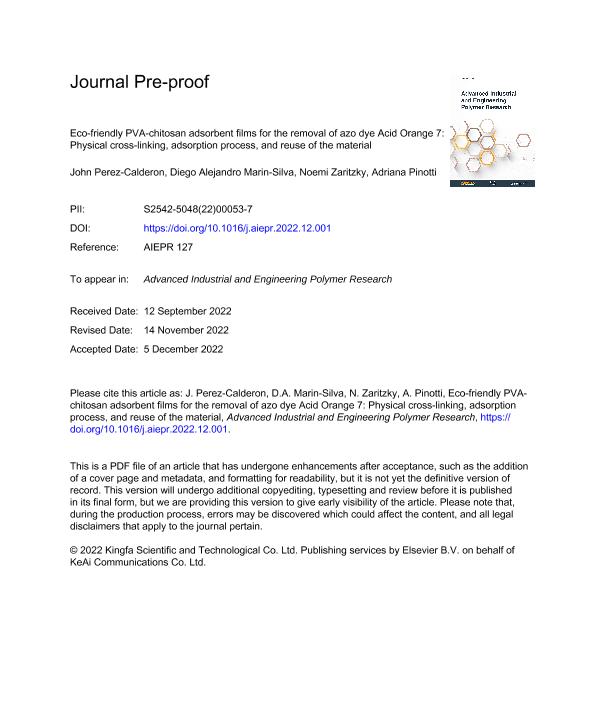Artículo
Eco-friendly PVA-chitosan adsorbent films for the removal of azo dye Acid Orange 7: Physical cross-linking, adsorption process, and reuse of the material
Perez Calderon, John Freddy ; Marín Silva, Diego Alejandro
; Marín Silva, Diego Alejandro ; Zaritzky, Noemi Elisabet
; Zaritzky, Noemi Elisabet ; Pinotti, Adriana Noemi
; Pinotti, Adriana Noemi
 ; Marín Silva, Diego Alejandro
; Marín Silva, Diego Alejandro ; Zaritzky, Noemi Elisabet
; Zaritzky, Noemi Elisabet ; Pinotti, Adriana Noemi
; Pinotti, Adriana Noemi
Fecha de publicación:
07/2023
Editorial:
Elsevier
Revista:
Advanced Industrial and Engineering Polymer Research
ISSN:
2542-5048
Idioma:
Inglés
Tipo de recurso:
Artículo publicado
Clasificación temática:
Resumen
The treatment of wastewater requires the use of eco-friendly and cost-efficient adsorbents. A hybrid adsorbent film based on biodegradable polymers (poly(vinyl alcohol) (PVA) and chitosan (Ch) was developed to remove Acid Orange 7 (AO7), an azo dye from the textile industry present in industrial wastewaters. The polymeric absorbent material was submitted to a curing process with different time-temperature combinations which improved its physical stability in aqueous media. This result was supported by modulated differential scanning calorimetry (MDSC) and thermogravimetric analysis (TGA). ATR-FTIR also confirmed the electrostatic interactions by hydrogen bonds between PVA and Ch, as well as among the polymers and the dye. The best curing condition to reach a high removal without weight loss was the combination of 160°C-1h. Dye adsorption depended mainly on pH, adsorbent dose, contact time, temperature, and coexisting anions. The maximum removal efficiency (>91%) was achieved at pH = 2.5. The adsorption kinetics followed the Lagergren pseudo first-order rate equation and the adsorption isotherm was best described by the Redlich-Peterson model. As far as the authors know, the maximum adsorption capacity (Qm) of the adsorbent film obtained in the present work is the highest value reported in literature (Qm = 678 mg/g at 298 K and pH = 2.5). Physisorption would be the dominant mechanism at pH 4.0 while at pH 2.5 the process was conducted by chemisorption. Regeneration studies showed that composites could be used for five consecutive cycles without losing their adsorption capacity. Thus, the use of the developed eco-compatible biodegradable materials would allow easy regeneration without losing removal selectivity, a key feature in the development of environmentally friendly sorbent materials.
Palabras clave:
AZO DYE
,
BIOSORBENT
,
CHITOSAN
,
HYBRID FILM
,
PHYSICAL CROSS-LINKING
,
PVA
Archivos asociados
Licencia
Identificadores
Colecciones
Articulos(CIDCA)
Articulos de CENTRO DE INV EN CRIOTECNOLOGIA DE ALIMENTOS (I)
Articulos de CENTRO DE INV EN CRIOTECNOLOGIA DE ALIMENTOS (I)
Citación
Perez Calderon, John Freddy; Marín Silva, Diego Alejandro; Zaritzky, Noemi Elisabet; Pinotti, Adriana Noemi; Eco-friendly PVA-chitosan adsorbent films for the removal of azo dye Acid Orange 7: Physical cross-linking, adsorption process, and reuse of the material; Elsevier; Advanced Industrial and Engineering Polymer Research; 6; 3; 7-2023; 239-254
Compartir
Altmétricas



